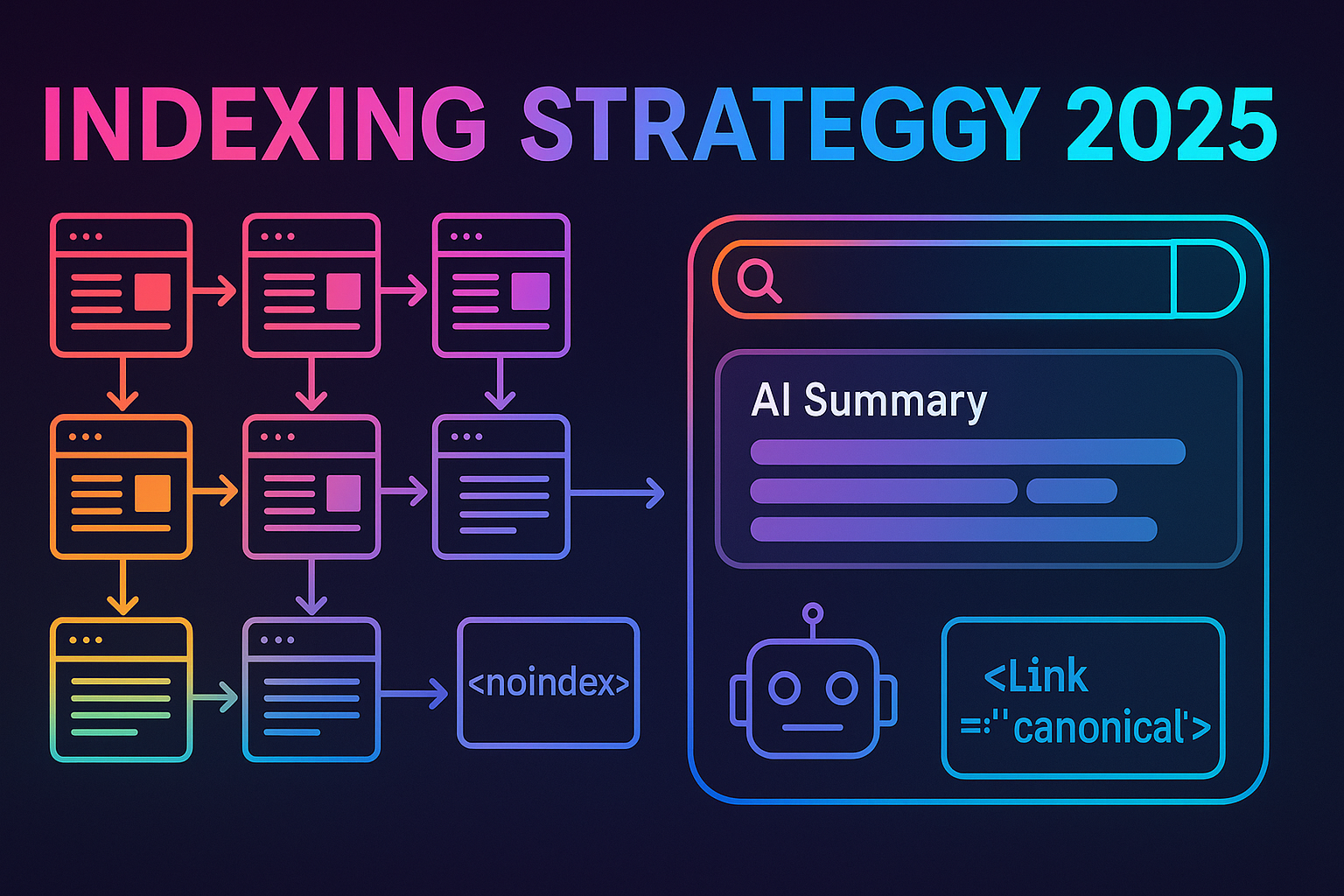A 2025 playbook to harden crawling, rendering, and indexing so your content survives AI summaries in SERPs. Canonicals, robots, sitemaps, JS reliability, pagination, hreflang, and measurement.
AI Summaries in SERPs: Proof Your Indexing Strategy (2025)
Introduction
AI summaries compress results and favor sources that are discoverable, renderable, and unambiguous. This guide hardens your crawling and indexing so your pages are eligible for both classic listings and AI-augmented surfaces. Use SEO Horizan tools to validate releases in minutes.
1) Crawl control: be easy to find, not just “allowed”
Keep the crawler path short, predictable, and canonical.
- Sitemaps: one index, logical splits (blog, docs, products). Keep lastmod accurate. Validate presence in /sitemap and submit via GSC.
- Robots.txt: disallow thin/duplicate params; allow primary templates. Don’t block resources needed to render core content.
- URL hygiene: lowercase, stable slugs, no session IDs. Resolve to a single scheme+host.
2) Canonical and duplication policy
AI summarizers and crawlers rely on clear canonical signals. Pick a canonical and defend it everywhere.
- Canonical per page: self-referential for primary pages; point variants (UTM, sort, filters) to the primary.
- Cross-domain: if syndicating, add
rel="canonical"to the original. - HTTP vs HTML: don’t contradict with
Link: <...>; rel="canonical"headers.
<link rel="canonical" href="https://example.com/blog/ai-indexing-2025">3) Robots meta, x-robots-tag & crawl-delay sanity
- Indexable pages: no
noindex, nonofollow. Double-check accidental template inheritance. - Headers: use
X-Robots-Tagfor file types (PDF/CSV) instead of on-page meta. - Crawl-delay: avoid in robots.txt unless truly necessary; it’s not standardized across crawlers.
Verify directives with Noindex Checker and HTTP Headers Lookup.
4) Renderability: server-first content, reliable JS
AI summaries and crawlers must see substance without fragile client rendering.
- Primary content server-rendered: headings, snippet paragraph (40–55 words), schema, and key images should exist pre-JS.
- INP and stability: reduce long tasks; keep CLS near headings/tables at ~0. Scan with TTFB Checker and Page Size Checker.
- Deferred islands: hydrate only what users interact with (accordions, tabs). Avoid blocking scripts in the head.
5) Pagination & faceted navigation
- Canonicalization: paginated series self-canonicalize; do not point all pages to page 1.
- Parameters: one canonical per intent; facets that create near-duplicates =
noindex,follow+ blocked from sitemaps. - Internal links: link to representative filtered states only if they have unique value (inventory, geography, use case).
6) Hreflang and regional parity
Mixed signals get dropped. Keep a closed loop.
- Each locale lists all alternates including itself; URLs are unique per language/region.
- Canonicals are language-self; don’t canonicalize en-GB to en-US.
7) Snippet paragraph & extractable evidence
AI summaries lift concise answers with proofs.
- Add a 40–55 word snippet under H1 (audience → task/outcome → 2–3 elements you provide). Confirm with Website Text Extractor.
- Place concise FAQ items near friction (pricing, limits, errors). Mark up only when visible.
- Use step tables and mini-benchmarks with dates and inputs—easy to cite.
8) Schema governance (truthful & minimal)
Article/BlogPostingfor guides;FAQPageonly when Q&A is visible.BreadcrumbListon all indexable templates to clarify hierarchy.- Keep JSON-LD text aligned with on-page copy; avoid synthetic reviews/ratings.
{
"@context":"https://schema.org",
"@type":"BlogPosting",
"headline":"AI Summaries in SERPs: Proof Your Indexing Strategy (2025)",
"description":"[40–55 word snippet here]",
"mainEntityOfPage":"https://example.com/blog/ai-indexing-2025"
}9) Link hygiene & canonical pathways
- Kill internal redirect chains and mixed-case/trailed variants.
- Ensure nav/footer/related blocks only point at canonical URLs.
- Audit regularly with URL Redirect Checker and Meta Tags Checker / OpenGraph Checker.
10) Monitoring & KPIs (indexing you can prove)
- Coverage: % of intended pages indexed; time-to-index after publish.
- Eligibility quality: snippet presence, schema validity, final-200 internal link rate.
- Performance guardrails: TTFB < 600 ms; payload < 2 MB; stable CLS; responsive INP.
Keep new releases discoverable via the Sitemap and review weekly in a single-owner scorecard.
Copy-and-paste indexing worksheet (CSV)
URL, In Sitemap (Y/N), Canonical OK (Y/N), Noindex (Y/N), Final-200 (Y/N), Snippet 40–55w (Y/N), Schema Valid (Y/N), Hreflang Loop (Y/N), TTFB<600ms (Y/N), <2MB (Y/N), INP OK (Y/N), Owner, Live Date
Internal links to include
- Blog hub (related guides)
- Plans (automation & governance)
- Sign-up or Login when relevant
- Ensure important pages are in your Sitemap
FAQs
Should I noindex filter pages?
Yes for near-duplicates. Keep one canonical browse state per intent; exclude param pages from sitemaps and add noindex,follow.
Do I need FAQ schema on every page?
No. Mark up only when the Q&A block is visible and directly answers common questions.
How fast should new posts index?
Target < 48–72 hours for priority templates. If slower, check sitemap freshness, internal links from high-authority pages, and rendering.
